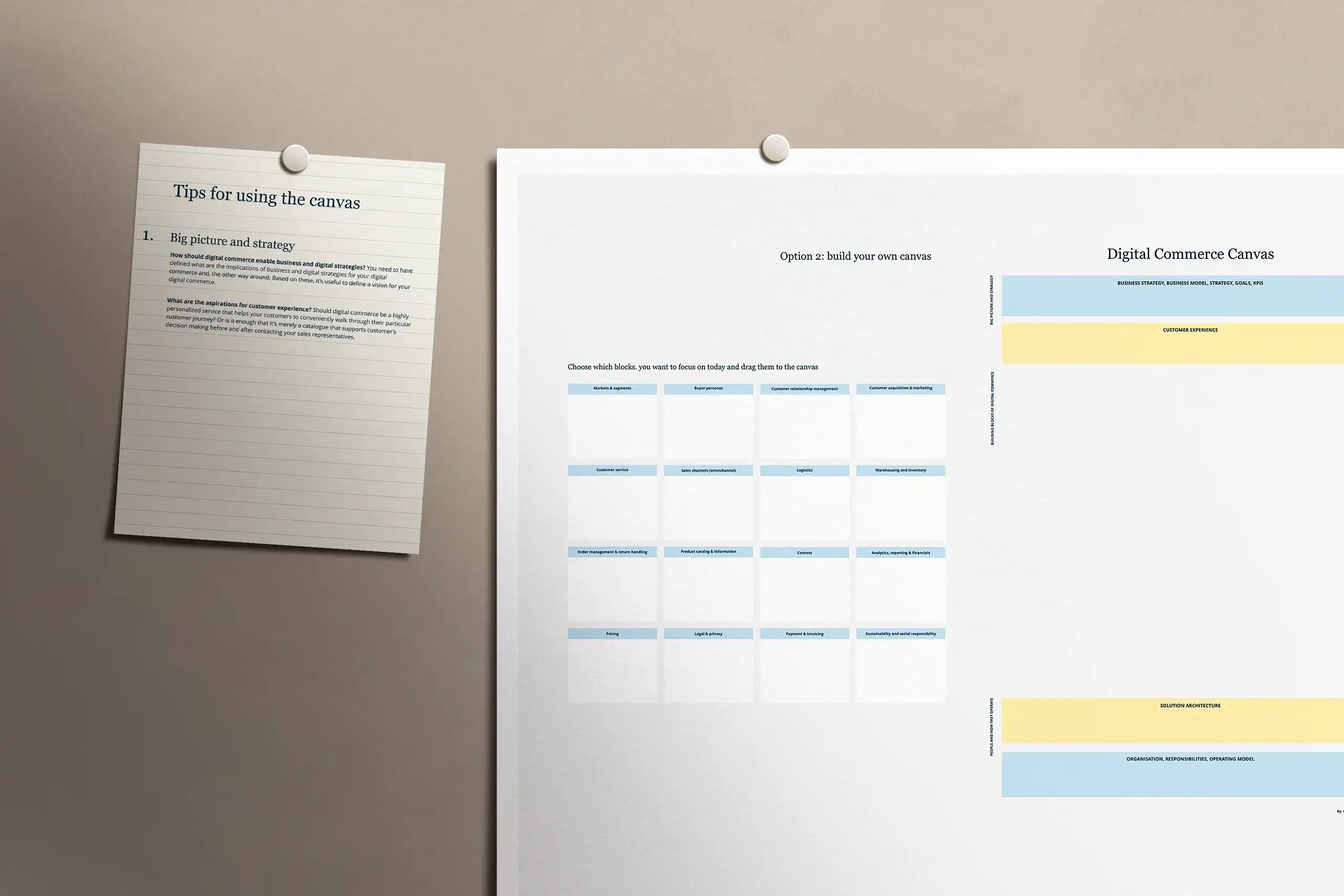The Data Handbook
How to use data to improve your customer journey and get better business outcomes in digital sales. Interviews, use cases, and deep-dives.
Get the bookRecently, we’ve seen more and more consumers preferring to shop for their favourite brands directly. In this article, we explore whether direct-to-consumer (D2C) can help your company sell better.
What is D2C?
Think of a brand whose products you see on sale at your local supermarket or nearest mall. I bet a lot of them also have their own sales channel where they sell directly to consumers. I, for example, have in the past months used D2C stores to order clothes from Adidas, a mountain bike from Canyon, coffee from Kaffa Roastery and a sofa from Kustom. To name a few.
Direct-to-consumer (D2C) is a business model where brands, manufacturers or B2B wholesale businesses start selling their merchandise to consumers directly without intermediaries such as retailers or wholesalers.
The D2C market has been growing fast in recent years. Both established brands and digital native players have been actively opening new sales channels to reduce the steps from manufacturing to consumer.
Even though pure D2C might not be the best business strategy, D2C as an additional sales channel makes a lot of sense. Let's look at why D2C might be a good move for your business and dive into the practicalities a bit.
Why would D2C make sense for your business?
Customer data
Knowing your customers is no doubt one of the biggest driving factors in starting a D2C sales channel. It is vital for businesses to know their customers to be able to improve their operations and sell better.
If you have a B2B business and are operating on a wholesale basis, more often than not, there is a distributor between you and the end-user of your products. This hinders the possibility of getting first-hand insights into customer behaviour and needs. Moreover, the death of third-party cookies makes having your own customer data even more important than it has been.
Selling directly to your customers allows you to gather first-party data and own the insights about them that have traditionally been held tight by retailers. The data will then allow you to optimise and grow your sales – and use the customer insights to create better products and services.
Brand
D2C is a great way to build brand recognition. When you own your channels, you are in control of how the brand is presented to the customers. D2C allows you to create unified customer experiences at each touchpoint where the customers come face-to-face with your products.
When the distributors are selling your merchandise, they might consider your brand as one of many that they are selling and do not pay that much attention to how you would like your brand to show up in the stores.
Innovation and experimentation
Having your own channel and access to first-party data makes it possible to innovate and experiment with new ideas with real customers and then validate the findings with data. With retailers involved, the feedback loop would be much slower, and the quality of the data you get back is not as good as the first-hand data.
You could also look into new ways of selling, such as creating subscription services, allowing your loyal customers to purchase new products before others or having a selection of online-only products that are not available anywhere else.
D2C channels
Marketplaces
Marketplaces are a good way to get started. For example, at Amazon, there are a lot of customers already browsing products, making it somewhat easier to get sales. The downside is that there is a limited possibility of owning your brand because the whole marketplace is owned and branded by someone else. This is also why the customer data that you get from the marketplaces is not on the same level as with the channel you own yourself. There are also additional costs involved making it possibly more expensive to operate there.
There are two kinds of marketplaces you could choose from; generic and domain-specific.
You could choose to start selling on a generic marketplace such as Amazon Marketplace. This can be relatively easy to start. A lot of ecommerce platforms have ready-made plugins available for connecting the new sales channel.
Another option is to go for a domain-specific marketplace such as Zalando Marketplace for fashion. This might be a better option to get quality traffic, who have already expressed interest in the kind of products you are selling.
In fact. we’ve explored getting started with selling at online marketplaces in one of our articles.
Webstore
Very often, the first choice in starting D2C is to set up a web store for your brand or one of the brands that you are selling. This is the most flexible way to get started but requires more effort than marketplaces. Your own webstore gives you a clean slate to decide how you want to sell and display your merchandise and brand online.
Practicalities and competences for D2C
Because B2B and B2C businesses have some fundamental differences, there are some concrete changes that need to be thought about when starting D2C operations.
Our Digital Commerce Canvas can help in mapping the required capabilities and your current state holistically to see where you would need to put in the effort to make your D2C start as smooth as possible.


Existing client relationships
Channel conflict is perhaps one of the biggest things that is hindering the move to D2C. Starting a D2C business means that you will essentially become a competitor for your resellers and can feel like putting the existing business at risk.
There are some ways to mitigate this, though. One could be to communicate the importance of customer data in improving your products for everyone’s benefit. Some other options could be having a separate online-only product selection available, or selling your product as a subscription service only. You could also agree on a pick-up from the reseller’s location for the orders made directly from your D2C channel to help the resellers get more foot traffic.
But one thing is for sure: being open about your plans and the justification behind them helps mitigate unpleasant surprises.
Warehouse and logistics
If you have an existing business running on a B2B domain, you need to think a bit differently when starting with B2C. Whereas in B2B, you are moving pallets of products and optimising delivery chains, in B2C, you need to collect, pack and ship individual products and orders and also handle returns. This is something that requires extra hands and, most often also, either a new logistics partner or new services from the existing partner.
Product selection
Some brands have opted to provide all their products in the D2C channel, making it easier for customers to find what they need. This is clearly a benefit for the customers; they can see the whole catalogue without the need to visit several resellers’ stores.
This might not be the best thing to do when starting out, though. It could be better to start out with a narrow, well-curated selection of products that you can use to ramp up your capabilities for the new channel.
Going forward, having your own sales channel provides opportunities to create and experiment with, for instance, online-only products and subscription services.
Customer data
In addition to having client accounts for the existing B2B business, you will have new consumer clients to take care of. This means that you will need to define what kind of data you need to collect, start actively collecting it and then store it and utilise it according to the regulations.
Marketing and sales funnel
Creating a new sales channel and collecting customer data won't do much good if nobody knows about you and the collected data is not utilised properly. You need to put some effort into the optimisation of the new sales funnel.
My colleagues have written great content about optimising marketing, nurturing leads and overall optimisation of the sales funnel. In addition, we also have a webinar about conversion rate optimisation (CRO). Be sure to check these out.
Marketing automation is still somewhat underutilised in many companies. It is a great tool to help you grow your D2C business both in the early stages of the sales funnel and in helping increase loyalty after purchase.
Customer support
Exposing the products to consumers will result in getting questions regarding products, delivery times, returns and so on. In order for the operations to go smoothly, you need to have personnel available to handle these contacts and support your customers with their purchases.
Payments
Your B2B operations might work with invoicing payments only. In case you do not have a consumer-friendly payment method available for your webstore, this is the time to set it up. There are plenty of options available. Some of them are covered in our earlier blog post about composable commerce tools.
Afterword
As noted above, when starting a D2C sales channel, there are many things to consider, and while technology plays an important role, the biggest changes are on the business side.
The actual effort needed depends a lot on your existing operating environment, both business and technical, and also on your (or your partner’s) capabilities.
D2C, like any digital sales operation, is not an IT project, but from a technical perspective, opening a new channel is much less painful if your tech stack is built in a composable commerce way and can be flexibly modified according to the new needs. If not, this might be a good time to take the first steps in that direction.
The Data Handbook
How to use data to improve your customer journey and get better business outcomes in digital sales. Interviews, use cases, and deep-dives.
Get the book



